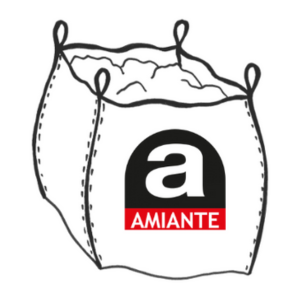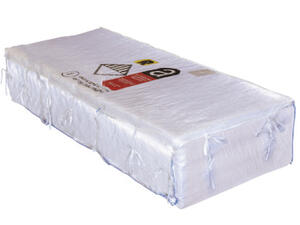Everything you need to know about different types of asbestos
Asbestos is a material that was once widely used in various industrial sectors due to its unique properties. However, its exposure can have severe consequences on human health, such as cancers and respiratory diseases. Unfortunately, many old buildings still contain asbestos, thereby exposing their occupants to significant risks. This text provides you with information about
the specifics of the two most common types of asbestos (amphibole and serpentine). OTEXIO also offers you information about their uses and the risks associated with asbestos exposure.
Amphibole asbestos
Amphibole asbestos is a type of asbestos that consists of
needle-like mineral fibers. These fibers are long and rigid, making them even more hazardous to human health. Before its risks were known, amphibole asbestos was widely used in various industrial applications due to its unique physical and chemical properties. There are several types of amphibole asbestos.
- Amosite, which was most commonly used in the industry for manufacturing various insulation materials, ceiling panels, and other construction materials.
- Crocidolite, which is the most dangerous form of asbestos to health. It was used in the production of steam engines, insulation pipes, and plasterboard.
- Anthophyllite, which is the least commonly encountered form of asbestos. Anthophyllite was used in producing vehicle brakes, floor coverings, and fire-resistant fabrics.
- Tremolite, is also a relatively rare form of asbestos. It was used in the paper industry and in the manufacturing of cement and paint.
- Actinolite, is also a rare form used in the production of tar paper, various coatings, and textured paints.
In France,
the use of amphibole asbestos has been prohibited since 1997 due to the health risks it poses. Nowadays, the use of amphibole asbestos is highly restricted worldwide. Its usage is strictly regulated in countries where it is still permitted.
Serpentine asbestos
Serpentine asbestos is a carcinogenic type of asbestos containing
serpent-shaped fibers. It consists of only one type of mineral silicate: chrysotile. Banned in France since 1997, it is unfortunately still exploited worldwide. White asbestos or chrysotile is valued for its resistance to heat and chemicals. It is used in the manufacturing of various construction elements and materials such as floors, roofs, or tiles. Compared to amphiboles, serpentine asbestos is considered less dangerous. The difference lies in the form of the fibers, which are larger and less easily inhalable. However, if you suspect the presence of asbestos in your home or workplace, we strongly advise you to have an assessment done. Following this analysis, you can proceed with asbestos removal if necessary. Also, note that the storage of this type of asbestos must be carried out under very strict confinement and safety conditions. Therefore, it is advisable to enlist a professional asbestos removal expert to perform these operations and to use appropriate asbestos storage materials, such as
asbestos big bags.



Table of Characteristics of Asbestos Varieties
| NAME AND CODE |
FAMILY OR TYPE OF ASBESTOS |
DESCRIPTION |
USE |
| Chrysotile or white asbestos / OSHA A1 |
serpentine |
Curly fibers |
Floors, roofs, tiles |
| Amosite or brown asbestos / OSHA A2 |
amphibole |
Thick and rigid fibers |
Insulation panels, stone sheets, thermal insulation material |
| Crocidolite or blue asbestos / OSHA A3 |
amphibole |
Short and pointed fibers |
Steam engines, insulation pipes, plasterboard |
| Anthophyllite / OSHA A4 |
amphibole |
Long and spindle-shaped fibers |
Vehicle brakes, floor coverings, fire-resistant fabrics |
| Tremolite / OSHA A5 |
amphibole |
Fibers in the form of crystals |
Talc, paper industry, cement, paint |
| Actinolite / OSHA A6 |
amphibole |
Crystals in the form of honeycombs |
Toilet seats, textured coatings and paints, tar paper |
Different uses of asbestos
Asbestos was widely used in the past for its extraordinary physical and chemical properties. Fire resistance, heat resistance, abrasion resistance, and durability: these characteristics made it an ideal product in construction, insulation, pipe manufacturing, and many other industrial fields. Here are the main examples of asbestos use:
- Thermal insulation of buildings, ships, and various other industrial equipment, such as boiler components.
- Sound insulation of buildings to isolate walls, ceilings, and floors in residential or commercial buildings, using panels made of cement and asbestos fibers.
- Manufacturing of construction materials due to asbestos's strength (roofs, tiles, cladding, partitions, false ceilings).
- Production of friction products due to its abrasion resistance, including the creation of brake pads, clutches, and sealing gaskets.
- Production of textiles with fire-resistant properties, including protective gear such as gloves or heat-resistant clothing.
Health hazards
In France, asbestos is recognized as
a carcinogenic and highly harmful material to human health, capable of causing serious respiratory diseases, and even death.
Diseases caused by asbestos
Inhaling asbestos fibers can indeed cause lung damage, the effects of which may only become apparent decades later. Individuals exposed over a long period are at risk of developing:
- Lung cancer
- Mesothelioma (cancer of the lining of the lungs or abdomen)
- Other respiratory diseases such as asbestosis
Risk factors for diseases
Professionals in the industry, construction, renovation, and individuals living in older, unreconstructed housing are vulnerable to the effects of asbestos. The risk of developing an asbestos-related disease depends on the following factors:
- Duration of exposure;
- Amount of inhaled asbestos;
- Frequency of exposure.
Preventing asbestos-related diseases
To avoid asbestos exposure, it's important to take
appropriate safety precautions. These preventive measures will help protect your health and that of workers involved.
- Wear protective equipment such as respiratory masks and use proper equipment for disposal.
- Inspect your home or workplace if you live or work in a building constructed before the 1980s.
- Follow guidelines for encapsulating, removing, and transporting asbestos-containing waste. It must be transported safely; preferably, seek professional assistance.
- Receive training on the dangers of asbestos exposure.
- Undergo regular screening if you're exposed to asbestos.
Asbestos is now banned in many countries due to the risks it poses to human health. If you suspect asbestos in your environment, it's important to have the situation assessed by a professional and to
conduct asbestos removal if necessary. This should be done using appropriate equipment, such as a
standard asbestos skip or a
ZIP asbestos skip. For all your specialized needs in asbestos waste disposal equipment, feel free to request a quote or contact OTEXIO at this number: +33 (0)4 78 52 06 51.


